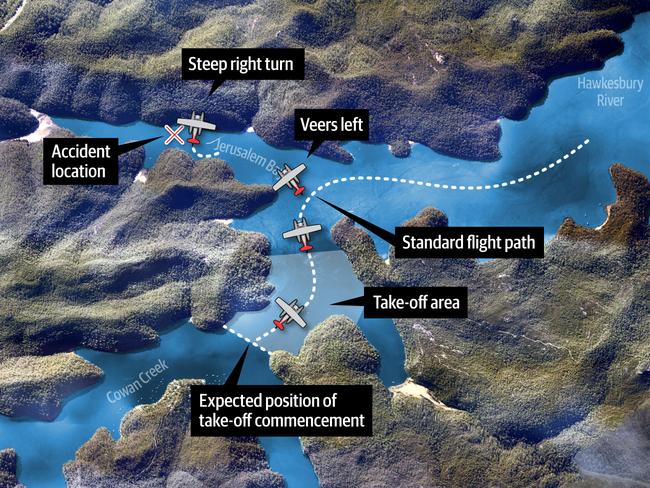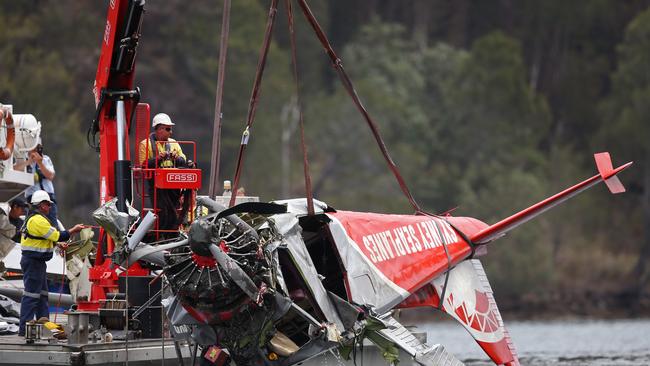Seaplane dramatically veered off course, initial report finds
THE pilot of the seaplane that crashed into the Hawkesbury River, killing all six people on board, had dramatically veered 1km off course into Jerusalem Bay, an initial inquiry has revealed.
NSW
Don't miss out on the headlines from NSW. Followed categories will be added to My News.
THE pilot of the seaplane that crashed into the Hawkesbury River, killing all six people on board, had dramatically veered 1km off course into Jerusalem Bay hemmed in by steep terrain before losing control of the aircraft.
A preliminary report by the Australian Transport Safety Bureau has found pilot Gareth Morgan, 44, may have become disorientated, distracted or incapacitated when he lost control of the de Havilland Beaver at Cowan Creek, taking a steep left turn off the standard flight path off the Hawkesbury River into Jerusalem Bay.

It is not yet known what caused the experienced pilot to veer off course at low altitude.
He had flown the route more than 500 times before with Sydney Seaplanes, for whom he had worked for four years — including three times on the day of the accident.
Aviation experts have ruled out engine and mechanical failure and state weather conditions were “ideal” and fuel had not been contaminated.
READ MORE:
FAMILIES LOOK FOR ANSWERS AFTER TRAGEDY
SEAPLANES RETURN TO SKIES WITH TWO PILOTS
SEAPLANE PILOT A ‘GENTLEMAN OF THE SKIES’
The report stated: “The aircraft was observed to enter the bay at an altitude below the height of the surrounding terrain. Several witnesses also reported hearing the aircraft’s engine and stated that the sound was constant and appeared normal.
“Shortly after entering Jerusalem Bay, numerous witnesses reported seeing the aircraft suddenly enter a steep right turn and the aircraft’s nose suddenly dropped before the aircraft collided with the water in a near vertical position.

“The entire tail section and parts of both floats were initially above the waterline.
“All six occupants received fatal injuries.”
The 55-year-old aircraft was scheduled to leave Cottage Point Inn about 3pm on New Year’s Eve and due to return to Rose Bay past Shark Rock Point, Jerusalem Bay and Cowan Creek along the Hawkesbury River.
However aviation experts say it had steered sharp left into Jerusalem Bay, from which there is no exit, and attempted a 90-degree bank angle turn in a bid to exit at low altitude, when the pilot appeared to lose control of the aircraft.


The 1963 model nosedived into the water with no time for the pilot to radio for help, killing him and British catering tycoon Richard Cousins, his fiancee Emma Bowden, her daughter Heather, 11, and Mr Cousins’ sons William, 25, and Edward, 23.
The seaplane took 10 minutes to submerge 14m below water.
ATSB air crash investigators are urging witnesses to help fill in the gap of exactly what happened between the plane landing for lunch at Cottage Inn and taking off again about 3.10pm, five minutes before it smashed into the water.
Crash teams are still examining the aircraft’s fuselage, wings, cockpit and main body components and will release full findings about sequence of events, information about the pilot and the cause of the crash in 11 months.
Mr Morgan had medical examinations weeks before the crash, with “a high standard of health” reported.
He held a valid Commercial Pilot (Aeroplane) Licence that was last reissued by the Civil Aviation Safety Authority (CASA) on March 21, 2017.
Sydney Seaplanes CEO Aaron Shaw described the crash as “tragic”.
“Since the accident, we have done everything possible to assist the ATSB, the NSW Police and CASA to understand how this tragic event occurred,” Mr Shaw said.
“Whilst the precise cause of the accident remains unknown, the preliminary report reflects the excellent flying conditions on the day and no evidence of airframe, fuel or engine issues.
“The key question arising from the report is why the plane crashed approximately half way down Jerusalem Bay, which is surrounded by steep terrain and has no exit?
“It is not a route we authorise in our Landing & Take Off Area Register and the plane simply should not have been where it was.”

The ATSB investigated a fatal accident involving the same single-engine DHC-2 Beaver on November 15, 1996 but it was subsequently repaired and issued with a Certificate of Airworthiness and re-entered service, registered as VH-NOO, in 2000.
In the past five years since February 2016, there have been 23 pilot incapacitation occurrences in Australia reported per year on average.
Nearly 75 per cent of pilot incapacitations happened in high capacity air transport operations (about 1 in every 34,000 flights), with the main cause being gastrointestinal illness, followed by laser strikes.
Sydney Seaplanes reopened operations two weeks after the crash using turbine-powered Cessna C-208 Caravan planes with two pilots recruited to each flight.
Anyone with information is urged to contact the ATSB witness information line on 1800 020 616.
KEY FINDINGS
1. The crash did not occur on a standard departure routing from the Cottage Point Inn. The accident occurred approximately half way down Jerusalem Bay on a flight path never undertaken by any Sydney Seaplanes.
2. The aircraft was then reported to enter in to an 80-90 degree bank angle turn. A turn of this nature at low altitude by a pilot with Gareth’s skills, experience and intimate knowledge of the location is totally “inexplicable” says Sydney Seaplanes.
3. The aircraft undertook a periodic inspection on the 6th of November 2017, after which a new maintenance release was issued. A maintenance release is a document certifying the aircraft is fit to fly with all required maintenance undertaken.
4. The engine had a total time of 195 hours since overhaul and had recently been inspected and test run by a maintenance facility in the United States.
5. The fuel on board was not contaminated by water or other visual particles.
6. There was no evidence of in-flight break up or pre-impact structural damage.
7. Flight control continuity indicated no evidence of flight control issues leading up to the accident.
8. The nearby weather reporting stations indicate wind strengths of 7 knots and 11 knots, and north easterly winds — ideal conditions.
9. An accident has occurred to an aircraft that at this stage appears to have no airframe or engine issues, operated by a highly skilled, experienced and trained pilot, in excellent weather conditions to a location he had flown to hundreds of times.
